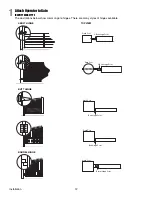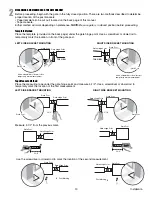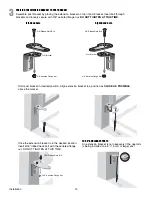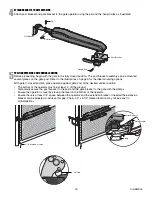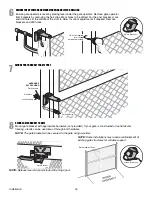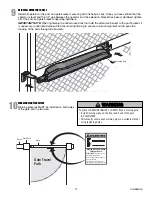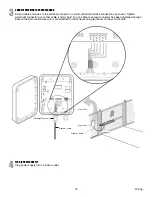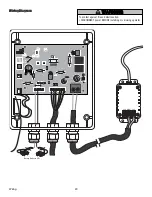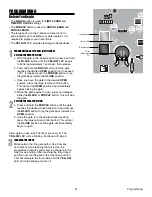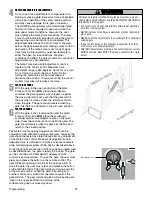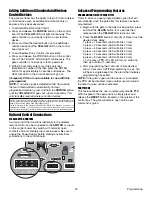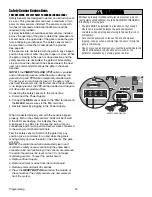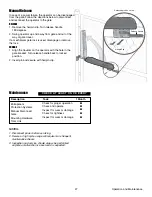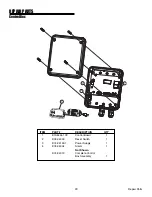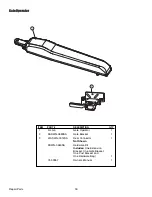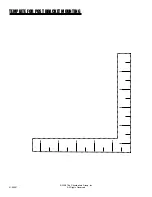
FORCE
MAX
MIN
R17
Outside Property
Inside Property
Sa
fet
y D
an
ge
r
GATE FORCE SENSITIVITY ADJUSTMENT
Do not use force adjustments to compensate for a
binding or sticking gate. Excessive force will interfere
with proper operation of the safety reverse system
and may cause damage to the gate or operator.
The GA200D gate operator will automatically detect
how much force is required to open and close the
gate under normal conditions, however, the user
must initialize the Gate Force Sensitivity. The Gate
Force must be carefully adjusted to allow the gate to
reverse when an obstruction is encountered. This
adjustment determines how much force is allowed
before the gate reverses after making contact with an
obstruction. If the Gate Force is set too light, gate
travel may be interrupted by nuisance reversals in
either the open or close directions. Weather
conditions can effect the gate movement, occasional
adjustments may be necessary.
The Gate Force Sensitivity Adjustment control is
located on the control board. Maximum force
adjustment range is 260 degrees, about 3/4 of a turn.
Do not force the control beyond that point. By
turning the Gate Force control clockwise will
decrease the amount of force and turning the control
counter clockwise will increase the force.
TEST CLOSE FORCE
With the gate in the open position and the Gate
Force control set to
MIN
, place the cardboard
container the gate operator was shipped in against
the close side latch post, such that the gate will hit
the box when it closes. Press the remote control to
close the gate. The gate should reverse when the
gate hits the box and return to the full open position.
TEST OPEN FORCE
With the gate in the closed position and the Gate
Force control set to
MIN
, place the cardboard
container against an entrapment area on the open
side. Press the remote control to open the gate. The
gate should reverse when the gate hits the box and
return to the closed position.
Adjustment Pot
Without a properly installed safety reversal system, persons
(particularly small children) could be SERIOUSLY INJURED or
KILLED by a closing gate.
• Too much force on gate will interfere with proper operation
of safety reversal system.
• NEVER increase force beyond minimum amount required to
close gate.
• NEVER use force adjustments to compensate for a binding or
sticking gate.
• If one control (force or travel limits) is adjusted, the other
control may also need adjustment.
• After ANY adjustments are made, the safety reversal system
MUST be tested. Gate MUST reverse on contact with a rigid
object.
ATTENTION
AVERTISSEMENT
AVERTISSEMENT
AVERTISSEMENT
WARNING
WARNING
CAUTION
WARNING
WARNING
PRECAUCIÓN
ADVERTENCIA
ADVERTENCIA
ADVERTENCIA
4
5
6
The Gate Force Sensitivity Adjustment control can be
adjusted to help eliminate nuisance reversals, however, the
gate should be tested as stated above after any adjustment
of the Gate Force control. Make small adjustments until
adequate force is obtained to minimize nuisance reversals
while maintaining reversals off the box as described above.
Once the gate travel and learn limit have been programmed
as described above, the gate is ready to be used. The gate
can be controlled via Chamberlain
®
wireless remote
controls (see Accessories). To open the gate, the user must
press and release the button on the remote control. The
gate will begin opening and stop at the open position. To
close the gate, the user must press and release the button
on the remote control. The gate will begin closing and stop
at the closed position. When the gate is traveling and
another command is given from the remote control, the
gate will stop. The next command given will make the gate
travel in the opposite direction and stop at the
corresponding open or closed position.
Programming
22





